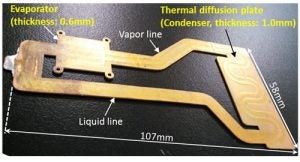Fujitsu’s liquid-cooling tech will do away with smartphone overheating

Fujitsu has developed a new technology that promises to drastically improve cooling systems in smartphones.
This means that handsets of the future will be able to offer improved processor clock speeds and better battery life thanks to the new cooling system.
It’s currently very difficult to keep smartphones cool, particularly as components are becoming progressively more powerful.
That’s because unlike computers, portable devices can’t accommodate blower fans or water-cooling pumps.
Fujitsu, however, wants to install a thin loop heat pipe onto components to reduce heat.
This pipe will be a closed loop carrying a liquid coolant. The warmth from the heat source evaporates the coolant, with the energy used to cause the evaporation transported away from the component.
It’s much the same as sprinkling water on a pavement to reduce heat on hot summer days.
The current approach to cooling smartphones is to install sheets of metal or graphite that are really good at absorbing heat.
These sheets then transfer heat away from heat-generating components like your phone’s processor, which helps avoid hotspots.

Fujitsu’s liquid evaporation cooling system
Fujitsu says its new technology is capable of transferring five times more heat than existing smartphone cooling technology.
“Smartphones, tablets, and other similar mobile devices are increasingly multifunctional and fast,” explained Fujitsu.
“These spec improvements, however, have increased heat generated from internal components, and the overheating of localised parts in devices has become problematic,” it continued.
“
Related: Best Smartphone 2015
Smartphone overheating has been a key focal point for the mobile market in recent months.
It was widely reported that Qualcomm’s new Snapdragon 810 suffered from substantial overheating issues, although the company denied the claims.
Samsung, however, decided to use its own chips in the Galaxy S6 rather than the Snapdragon 810, which could suggest there was some truth to the rumours.
Whatever the case, we probably won’t see Fujitsu’s cooling tech until the Galaxy S8, however. The Japanese company wants to bring the technology to handsets by 2017. Stay tuned.


